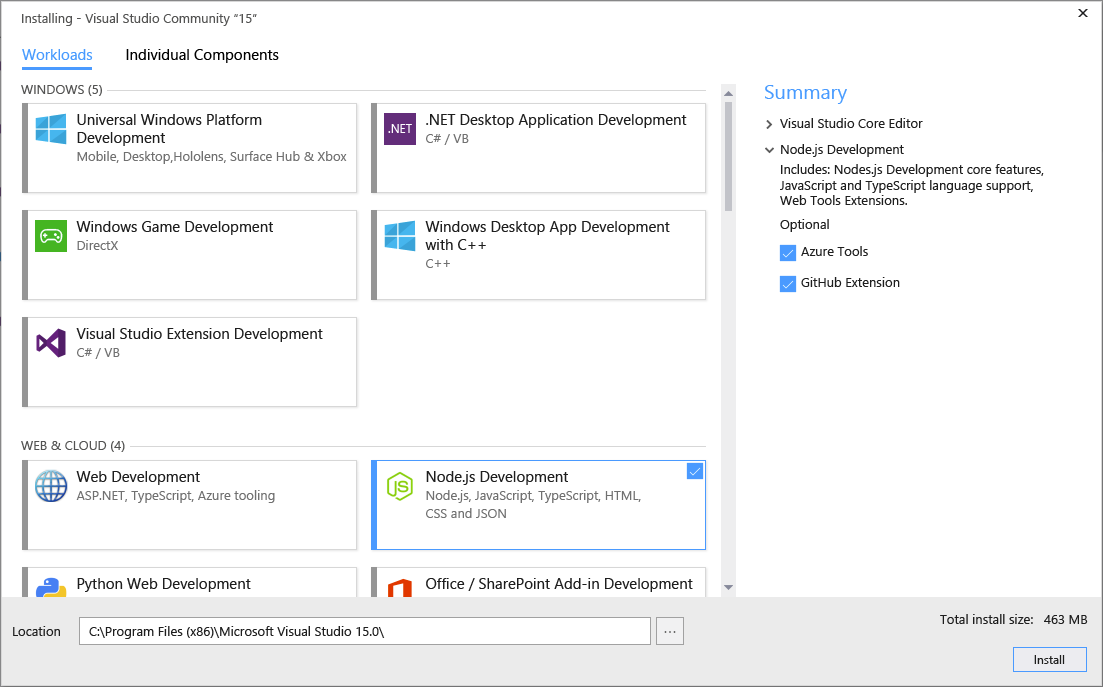On the Road to Release: Redesigning Visual Studio Installation
For those of you who have been closely tracking the progress of our next release of Visual Studio (codenamed Visual Studio “15”), you’ll know that one of our big product release themes is installation and update. We are refactoring our installation to be smaller by default, faster and more reliable, and easier to manage, as described in this previous blog post:
Faster, Leaner, Focused on Your Development Needs: The New Visual Studio Installer
At //build, we shipped our first experimental preview of the new installation experience, with the smallest “core editor” payload for Visual Studio weighing in at about 320MB on disk. This release (and the Preview 2 that followed) included a few targeted experiences – .NET desktop, Python, C++ and Unity – that gave us early feedback about the approach. The teams are now converting other tooling components of Visual Studio to the new low-impact installation model so that we can ultimately switch out the ‘classic’ installer for our new experience and setup engine.
Installation Experience
Setup is probably the only experience that every Visual Studio customer shares, and we want a lot of feedback on it before we finalize the design. Later this summer, we’re going to have a version of Visual Studio “15” with the new installer UI. Before that comes out, though, we have something else to share with you – something we don’t normally share: our rough UI mockups. These are what we call “blue lines.” Like blueprints, these aren’t high fidelity mockups. They’re a little better than wireframes, and they give us a sense of the various paths customers might take through a UI. We’d like to ask you to step through the mockups and take our short survey to give feedback.
Choose Your Stack, Get a Tailored Install
Something else we’d like feedback on: the “workloads” that we’re aggregating together. Visual Studio will always have an advanced setup option where you can install features at a pretty granular level, and in Visual Studio “15” we’ll give you even more control than you have in VS today. But most often, customers tell us they just want to install C++ for desktop development or C# for web development – a “workload.”
We’ve been doing research into what the right collection of workloads should be, and we’ve come up with the following:
- Universal Windows Platform development
- Web development (incl. ASP.NET, TypeScript, Azure tooling)
- Windows desktop app development with C++
- Cross-platform mobile development with .NET (incl. Xamarin)
- .NET desktop application development
- Linux and IoT development with C++
- Cross-platform mobile development with Cordova
- Mobile app development with C++ (incl. Android, iOS)
- Office / SharePoint add-in development
- Python web development (incl. Django and Flask support)
- Data science and analytical applications (incl. R, F#, Python)
- Node.js development
- Cross-platform game development (incl. Unity)
- Native Windows game development (incl. DirectX)
- Data storage and processing (incl. SQL, Hadoop, Azure ML)
- Azure cloud services development and management
- Visual Studio extension development
So how does all this come together? Here’s an early, work-in-progress preview of how we think this will look:
One final note. Normally, we ask for you to give feedback in comments to the blog post or through Connect or some other system. This time, we’re really asking everyone to use the survey, so we can further refine and improve our approach in a systematic way.
Thanks! Tim Sneath, Principal Lead Program Manager, Visual Studio Platform


 Light
Light Dark
Dark
0 comments